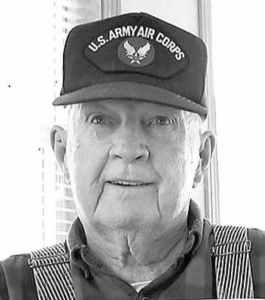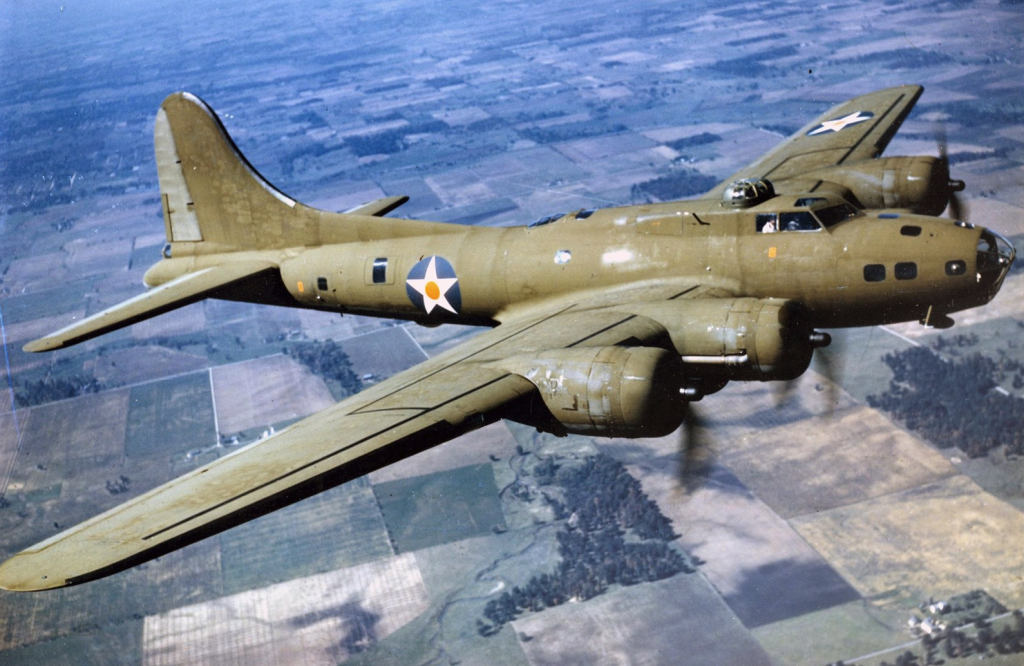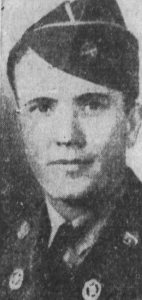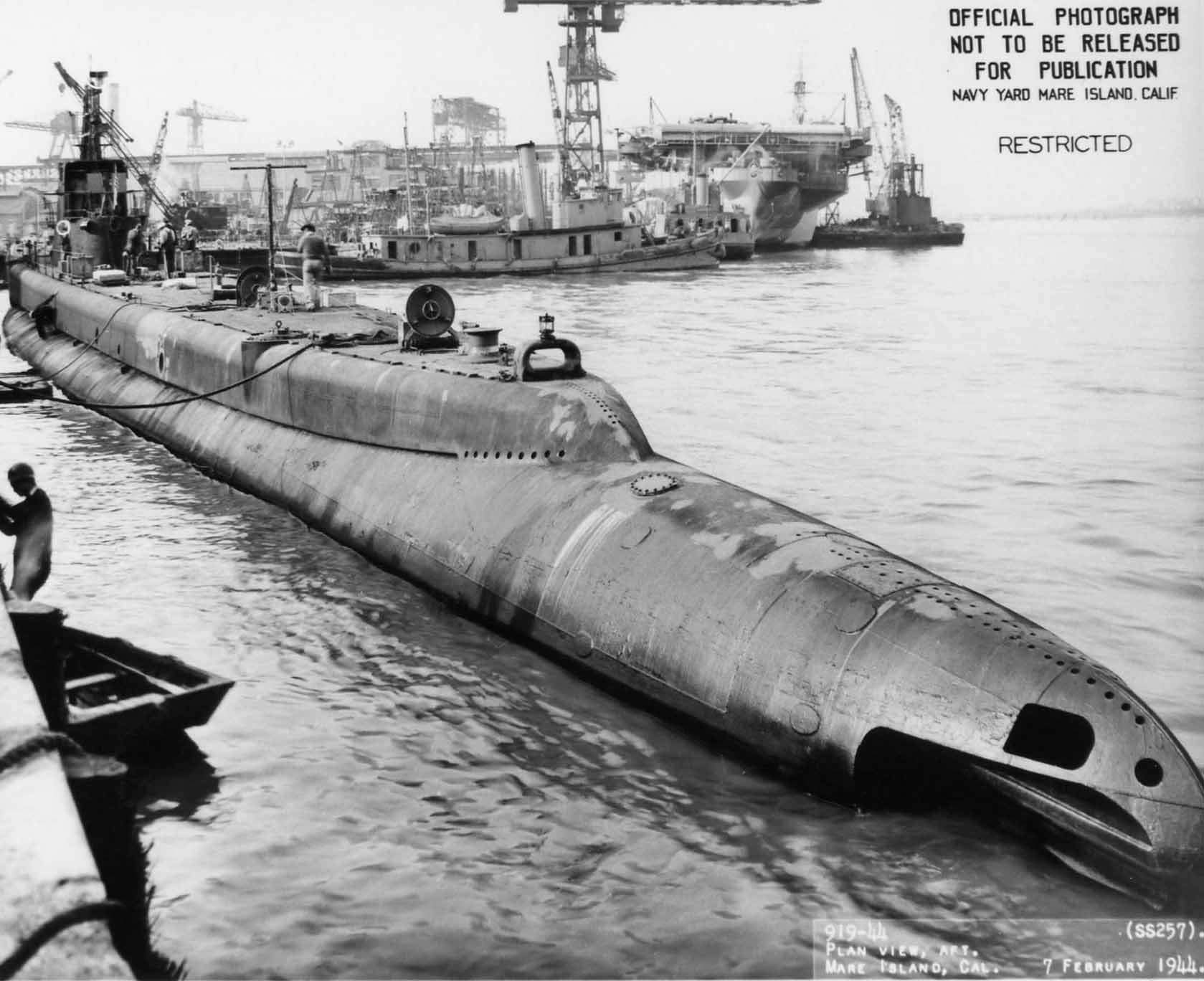Throughout WWII, military personnel displayed uncommon valor and courage. Our record collections contain countless stories of ordinary men and women who serve in extraordinary ways. Here are two remarkable stories of survival.
Eugene P. Moran enlisted in the US Army Air Corps on October 21, 1942. The Wisconsin native served as a Staff Sergeant in the 339th Bomb Squadron, 96th Bomb Group, 8th Air Force. On November 29, 1943, while serving as a tail gunner in a bombing mission over Bremen, Germany, Moran’s B-17 Flying Fortress was hit by German flak. The B-17 was cut in two, sending Moran hurtling toward earth in the tail section. A bail-out was impossible because Moran was wounded in both arms, and his parachute was riddled with bullets. The damaged vertical fin and horizontal stabilizers fluttered and flapped, helping to slow his fall. After falling 24,000 feet (more than four miles), one of the tail’s stabilizers stabbed into a tree, and Moran abruptly stopped. He was severely injured, suffering wounds, back injuries, and head injuries.
Out of the crew of ten, Moran was one of two survivors. He was captured by German soldiers and taken POW. His captors denied him medical attention, but a Serbian doctor, also a POW, rendered aid and likely saved his life. Over the next 17 months, Moran was held prisoner at POW camps in Germany, Prussia, and Poland. He spent time on a “hell ship” on the Baltic (so-called for the horrific conditions Allied prisoners endured while on board). He also survived a forced 600-mile march. Moran endured his time as a POW and was liberated on April 26, 1945, by the 104th Infantry Division. He was awarded two Purple Hearts, an Air Medal with Gold Leaf Cluster, the European Theater Medal, and a Good Conduct Medal. In 2007, Moran became the first recipient of the Veteran Lifetime Achievement Award in Wisconsin. He passed away in 2014 at the age of 89.
Sgt. James A. Raley of Henderson, KY, served as a tail gunner in the 353rd Bomb Squadron, 301st Bomb Group, Fifteenth Air Force. He was on a bombing mission to Piraeus, Greece, on January 11, 1944, when his aircraft collided mid-air with another B-17 in heavy cloud cover. The tail section was severed, and Raley was caught in the wreckage. In a 1944 newspaper interview, Raley said, “When the crash occurred 19,000 feet in the air, there was a terrific impact, and I was thrown face down on the floor toward the rear of the fort. I had an immediate sensation of falling as the plane spiraled downward, twisting to the right in a tight circle. My first thought was to grab my parachute and get out of the plane, but the spinning made it impossible for me to move.”
Raley recited prayers during the descent. “I must have been spiraling downward for 10 to 15 minutes,” he said. The tail came to rest in a clump of treetops. Raley realized he had just survived a fall from 19,000 feet. He was worried the aircraft might catch fire or explode and was anxious to clear the wreckage. He made his way to the bulkhead door, but the rest of the aircraft was gone when he opened it. Eight members of the crew died in the tragic accident.
Raley suffered back injuries and a small cut on the chin but miraculously survived. He was awarded an Air Medal and a Bronze Oak Leaf Cluster. Despite his near-death experience, Raley continued to serve in the military. He served in the Korean War and the Vietnam War, attaining the rank of Lt. Col. in the US Air Force. Raley passed away in 1999.
There are many more stories of survival in our archives. If you would like to explore our collections for more amazing but true stories, search Fold3® today.








A harrowing story of survival. Thankful he survived the mid-air plane in 1944. And am grateful for his strength to continue to serve our country in the Korean War and Vietnam War. He lived a long life. Bravo
There’s so many stories of men & women surviving being shot, serious landings, horrendous P.O.W. conditions, etc. etc. These soldiers, airman, sailors, WACS, nurse, proved their mettle throughout our conflicts.
God Bless them!
AMEN! GOD BLESS AMERICA!
Here’s my local history column about Sgt. James Raley’s astounding career, which originally appeared in The Gleaner of Henderson, KY.
Yesterday’s News for 4-7-2019
Headline: Henderson soldier fell 3.7 miles – and lived – during World War II
It was just before 1 p.m. on Jan. 11, 1944, that Sgt. James A. Raley fell into the rest of his life.
Anyone else would have died after plummeting 3.7 miles in the tail of a B-17 bomber that had been sheared off in a collision with another bomber. If that wasn’t bad enough, he landed in German-occupied Greece.
I guess you could say he was lucky. Or fated. Or even that God had other plans for him.
Raley’s story has been written numerous times – he even told it himself in an autobiography – and it has taken on almost mythological status. Minor details differ in various accounts. But the skeleton of the story stands solid.
He was born in Henderson May 25, 1916, the son of W.G. and Mary Raley, and attended Weaverton School.
He had joined the U.S. Army seven years earlier and his initial combat experience was with the 1st Armored Division in North Africa. While in Tunisia he and other members of his unit witnessed from a hilltop the surrender of German forces in North Africa, according to The Gleaner of May 17, 1944.
The Gleaner of May 7 reported that “after the Tunisian campaign Sergeant Raley found that time was rather dull, so he applied for admission into the Air Corps.”
A letter to one of his four brothers said he had swapped his typewriter “for two beautiful machine guns” when he became a tail gunner in a B-17 Flying Fortress, according to the preface The Gleaner added to the Associated Press story it printed April 11.
That was exactly three months after his plane had been reported missing while attempting to bomb Piraeus harbor at Athens, Greece. Full details of the accident appear to have been hushed up during World War II. Raley’s official report was classified until 1973. An August 2017 article in Maturity Journal by Harold Morgan says two bombers in the leading elements turned around – sources disagree on why — and collided with the second group.
Raley’s plane led that second group of bombers.
“I was still at the tail gun, looking out,” Raley said in the 1944 AP story. “The navigator had just called out the altitude – 19,500 feet. He was going into a fog bank.
“Then it came. There was a hell of a jolt. The plane seemed to stop.” He found himself on his face, pinned down by ammunition and parts.
“I knew we were spinning around because flashes of blue, green and brown kept flashing past…. I thought the whole ship was intact by the way it was twisting around and the time it was taking us to get down. I was praying, too. I was telling myself in another few minutes I’ll be dead.”
The impact was – considering the circumstances – surprisingly soft because the bomber’s tail had fluttered down like a falling leaf. The official Army Air Force casualty report Raley filed May 4, 1944, says, “The tail section landed in a clump of small trees which broke the fall sufficiently to permit me to escape practically unscathed.”
With considerable difficulty Raley freed himself from several hundred rounds of ammunition on his neck and back, found his shoes, and rounded up three candy bars.
The hatch he normally would have gone through was flush with the ground and unusable. So he opened the bulkhead that connected with the rest of the plane.
“I got the shock of my life,” he said. The tail section, the last 12 feet, was all that remained of the bomber affectionately named “Skippy.”
“All I could see was geography – in quantity,” he wrote in his 1945 autobiography. “I half-climbed, half-fell from tree to tree down the near perpendicular mountainside” till he came to a trail.
He sat on a boulder and, before long, was lying across the trail. It began raining. After a few hours he heard voices. He shouted and a handful of Greek men came and helped him down the mountain to a monastery, where the Greek Orthodox priests had given shelter to other Allied personnel.
An April 16, 1944, Associated Press photograph shows Raley being treated by Army nurse Lt. Ruth Dalton of Minneapolis for the “cut on his chin” he sustained in his fall.
But his injuries were more serious. A collection of letters from B-17 crewmen on that mission, placed on FamilySearch.org by Lloyd Rappleye, quotes Neil Daley describing Raley’s arrival at the monastery in a letter dated July 10, 1996.
“Later that evening the last man, Sgt. Jim Raley, was carried in and deposited on a plank adjacent to mine. He was like a raving maniac and kept repeating, ‘I have to tell somebody what happened to me.’”
Like Daley, who came down in a torn parachute, Raley sustained internal injuries. “One of his legs was badly bruised and various other parts of his body were damaged. He needed, and received, the services of the doctor that evening.”
Raley and Daley hobbled around the monastery on crutches until they felt well enough to travel to Mikalaka on Jan. 23. There were then many “false starts” before they were evacuated from Greece April 3. The next day the ship Raley was on arrived in Taranto, Italy.
The Gleaner of May 7 reported that “the original fall guy is home,” after receiving a field commission as 2nd lieutenant. It’s unusual for a non-commissioned officer to make a battlefield jump to 2nd lieutenant. “It takes at least three officers to recommend you for that.”
Raley’s miraculous escape from death had “excited the attention of the whole nation.” But no one was more excited than his father, who managed the William D. Lambert farm on Zion Road. “He never had hoped to see his son again and when he saw him walk across the yard of their farm home he couldn’t believe his eyes.”
Raley suspected there were more than two bombers involved in the mid-air collision, and “as far as I know I am the only member of the crew of my ship to escape the crash.”
Rappleye’s site lists the eight B-17 bombers that rained from the sky in pieces that day, as well as the names and fates of the 77 airmen who were on them, 64 of whom died. Only 13 of them survived. It was Raley’s 13th mission and he was the only survivor who didn’t use a parachute.
Raley’s squadron was part of 301st Bombardment Group and its webpage says, “After the war James Raley visited the families of all of the crew members and later married the pilot’s widow.”
Not quite. She was the 22-year-old widow of the co-pilot, 2nd Lt. Henry J. Sudol. James Raley and Lorraine Lineberry Sudol of Wadesboro, North Carolina, married July 30, 1947, and brought three daughters and a son into the world. Raley had seven grandchildren when he died April 28, 1999, at his home in Winter Springs, Florida, at age 82.
He was a career Air Force veteran who served during World War II and the Korea and Vietnam conflicts. He retired with the rank of lieutenant colonel and is buried in Arlington National Cemetery.
His was an accomplished and meaningful life. You could call it a miracle snatched from the jaws of fate.
Thanks for sharing! Such an amazing story!
Great story of one man in the greatest generation ever!! I’m sure there are many stories that have never been told. Thank you for sharing.
Thanks very much. I enjoyed researching and writing this one.
Wow we never know what is in store for those who put themselves in harms way for man kind. God Bless them all; and them who are in the Service today. One never knows what History holds them……
Thank you. Very courageous men!
This is a true hero! I will say a prayer for you in the morning. August 25.
John USMC retired
VERY INTERESTING STORIES OF THE HEROS OF WORLD WAR II, THANKS FOR SHARING. GOD BLESS ALL THE SERVICE MEN & WOMEN THAT HAVE & ARE CURRENTLY SERVING THE U.S.A.
Thanking for sharing. It’s an amazing story of survival.
God bless all.
This story and many more like it are why these brave men and women are referred to as the greatest generation. My dad and father in law were 2 of them.
Our uncle Ralph Burbridge was a bombardier on a B-17 called the All American and flew 52 missions over Europe. The plane was hit by enemy fire with the tail almost severed. They were able to limp the plane back to Africa with all arriving safely. We are very proud of our uncle and always enjoyed his stories. He wrote a small memoir titled On a Wing and a Prayer that can be found on Amazon. He was a true hero.
Well said Shawn.
And they would probably tell us that they were just “doing their job”. Amazing stories of service and heroism that need to be remembered.
I loved these stories about brave aviators who dodged death by sheer luck and a lot of prayers. My dad was a co-pilot on a B24 in the Pacific Theatre during WWII. Luckily, he made it back after the completion of 33 missions.
WOW! S/Sgt Raley served in what would later be my brother’s Squadron. He didn’t join the outfit until August 1944.
Truly amazing stories. I guess the tail wasn’t always the worst place to be!
Thanks for sharing such amazing stories! My Dad was a pilot in the 2nd WW. I admired him so much for his courage and bravery! He didn’t talk much about it but I do know that he felt like all the men he served with were is brothers and never missed a reunion! I have been told that all the records of his service were in a fire so I don’t know much about his service. He flew in the Pacific theater and it was the 31st Squadron. I am not sure what plane he flew.
I am thankful to all the brave men and women who have served! Thank you for your service.
“All his records burned in a fire.” That is the standard explanation, but it may or may not be true. The fire occurred in 1973, and certain files, in certain letters of the alphabet, WERE burned. Just knowing the 31st Squadron is a great help. Your father was a fighter pilot. See https://en.wikipedia.org/wiki/31st_Combat_Training_Squadron
If you wish to pursue this, write your local Member of Congress to request your dad’s records. It is the quickest and easiest way for you to get them. It helps if you have his Serial Number, but if he had a unique or uncommon name, that works well, too. BE SURE TO WRITE THAT HE SERVED IN THE 31ST PURSUIT (OR FIGHTER) SQUADRON. Once you receive his records you can do historical research over the internet to learn about your father’s unit. If you live near the National Archives in College Park, MD, you can visit there and see the actual WW II records.
The Air Corps was first organized into Squadrons. 3 or 4 Squadrons composed a Group, and several Groups made up a Wing, and several Wings formed a Numbered Air Force. For example, my brother’s units were the 353d Squadron, 301st Bomb Group, 5th Wing, Fifteenth Air Force.
I wish you great success!
A new book about Gene Moran was published recently called Tailspin. It was written by a history teacher who knew him and interviewed him extensively. He spoke at a conference I attended last month. It’s for sale on Amazon at https://www.amazon.com/Tailspin-John-Armbruster/dp/1645383148/. He was an amazing guy!
My Father is 100 yrs old and still living in a assistant living facility. He still has a fairly sharp mind.
His name is Eugene G. Spicer, and was stationed at Ft Meyers, I think Polk field.
He was then sent to the Tinnein Island. That’s is about all I know. Any info you can tell me or instruction for info would be appreciated . . . ML Spicer
Write your local Member of Congress via his website to request his military file. If possible, give his Serial Number; otherwise, his full name and date of birth.
Absolutely amazing. Thank you for sharing!
I’ve collected a lot of stories like Moran’s on a web site I call the Free Fall Research Page. He’s a Wreckage Rider because of the way he came down in the tail of his B-17. There are more than 30 stories like his from World War II.